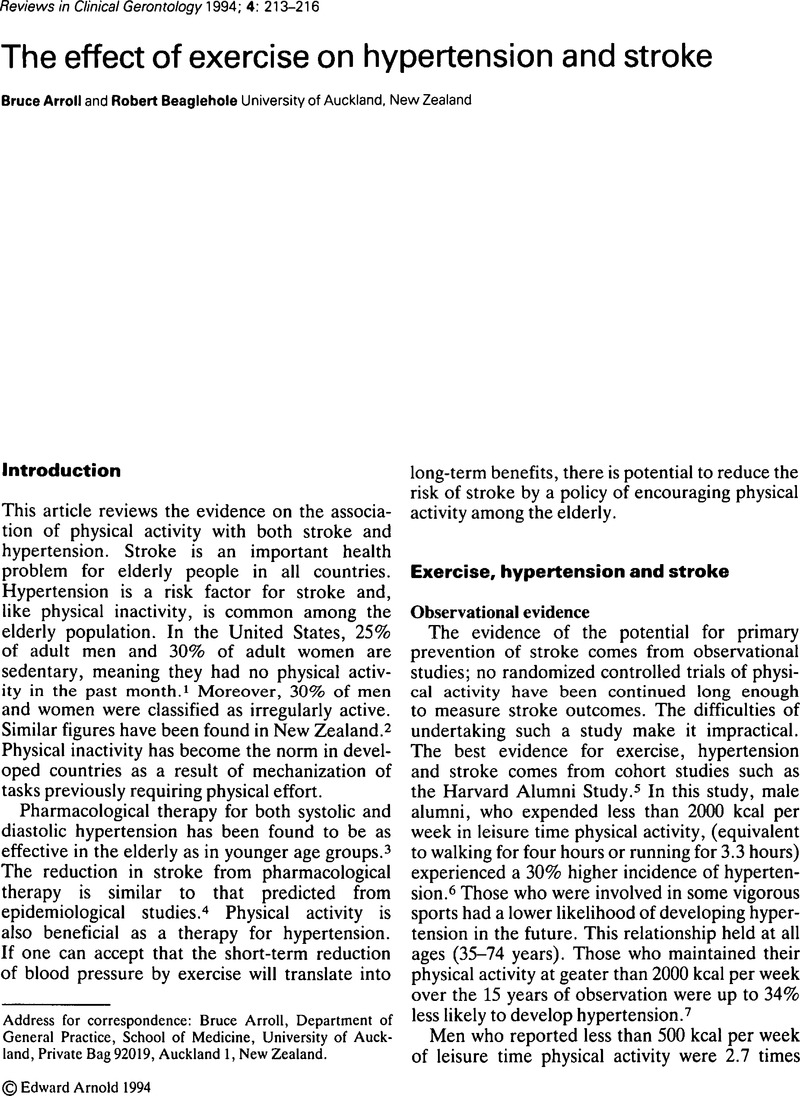No CrossRef data available.
Article contents
The effect of exercise on hypertension and stroke
Published online by Cambridge University Press: 17 November 2008
Abstract
An abstract is not available for this content so a preview has been provided. Please use the Get access link above for information on how to access this content.

- Type
- Clinical geriatrics
- Information
- Copyright
- Copyright © Cambridge University Press 1994
References
1Casperson, CJ, Powell, KE, Christenson, GM.Physical activity, exercise, and physical fitness: definitions and distinctions for health-related research. Public Health Rep 1985; 100: 126–31.Google Scholar
2Hillary Commission for Recreation and Sport. Life in New Zealand. Wellington: Hillary Commission for Sport, Fitness and Recreation, 1990.Google Scholar
3Beard, K, Bulpitt, C, Mascie-Taylor, H, O'Malley, K, Sever, P, Webb, S.Management of elderly patients with sustained hypertension. Br Med J 1992; 304: 412–16.CrossRefGoogle ScholarPubMed
4Collins, R, Peto, R, MacMahon, S, Herbert, P, Fiebach, NH, Eberlein, KA.Blood pressure, stroke, coronary heart disease. Part 2: short term reductions in blood pressure: overview of randomised drug trials in their epidemiological context. Lancet 1990; 1: 827–38.CrossRefGoogle Scholar
5Paffenbarger, RS, Hyde, RT, Wing, AL et al. A natural history of athleticism and cardiovascular health. JAMA 1984; 252: 491–95.CrossRefGoogle ScholarPubMed
6Paffenbarger, RS, Wing, AL, Hyde, RT et al. Physical activity and incidence of hypertension in college alumni. Am J Epidemiol 1983; 117: 245–57.CrossRefGoogle ScholarPubMed
7Paffenbarger, RS, Wing, AL, Hyde, RT, Lee, I, Jung, DL, Kampert, JB.The association of changes in physical activity level and other lifestyle characteristics with mortality in men. N Engl J Med 1993; 328: 538–45.CrossRefGoogle Scholar
8Wannamethee, G, Shaper, AG.Physical activity and stroke in British middle aged men. Br Med J 1992; 304: 597–601.CrossRefGoogle ScholarPubMed
9Paffenbarger, RS, Brand, RJ, Sholtz, RI, Jung, DL.Energy expenditure, cigarette smoking and blood pressure level as related to death from specific causes. Am J Epidemiol 1978; 108: 12–18.Google Scholar
10Berlin, J A, Colditz, GA.A meta-analysis of physical activity in the prevention of coronary heart disease. Am J Epidemiol 1990; 132: 612–28.CrossRefGoogle ScholarPubMed
11Arroll, B, Beaglehole, R.Does physical activity lower blood pressure. A critical review of the recent literature. J Clin Epi 1992; 45: 439–47.CrossRefGoogle Scholar
12Hurley, BF, Seals, DR, Eshani, AA et al. Effects of high-intensity strength training on cardiovascular function. Med Sci Sport Exerc 1984; 16: 483–88.CrossRefGoogle ScholarPubMed
13Harris, KA, Holly, RG.Physiological response to circuit weight training in borderline hypertensive subjects. Med Sci Sports Exerc 1987; 19: 246–52.CrossRefGoogle ScholarPubMed
14Hurley, BF, Hagberg, JM, Goldberg, AP et al. Resistive training can reduce coronary risk factors without altering VO2 max or percent body fat. Med Sci Sport Exerc 1988; 20: 150–54.CrossRefGoogle ScholarPubMed
15Blair, SN, Kohl, HW, Gordon, NF, JrPaffenbarger, RS.How much physical activity is good for health. Annu Rev Publ Health 1992; 13: 99–126.CrossRefGoogle ScholarPubMed
16Siscovik, DS, Weiss, NS, Fletcher, RH, Lasky, T.The incidence of primary cardiac arrest during vigorous exercise. N Engl J Med 1984; 311: 874–77.CrossRefGoogle Scholar
17Nelson, L, Esler, MD, Jennings, GL, Korner, PI.Effect of changing levels of physical activity on blood pressure on hemodynamics in essential hypertension. Lancet 1986; 11: 473–76.CrossRefGoogle Scholar
18American College of Sports Medicine. The recommended quantity and quality of exercise for developing and maintaining cardiorespiratory and muscular fitness in healthy adults. Med Sci Sport Exerc 1990; 22: 265–74.Google Scholar
19Meredith, IT, Jennings, GL, Esler, MD.Time-course of the antihypertensive and autonomic effects on blood pressure on hemodynamics in essential hypertension. J Hypertens 1990; 8: 859–66.CrossRefGoogle Scholar
20Hagberg, JM, Mountain, SJ, Wade, H et al. Effect of exercise training in 60–69 year old persons with essential hypertension. Am J Cardiol 1989; 64: 348–53.CrossRefGoogle Scholar
21Grassi, G, Servalle, G, Calhoun, D, Bolla, G, Mancia, G.Physical exercise in essential hypertension. Chest 1992; 101: s312–14.CrossRefGoogle ScholarPubMed
22Wood, PD, Stefanik, MI. Exercise fitness and atherosclerosis. In: Bouchard, C ed. Exercise fitness and health: a consensus of current knowledge. Champaign, Il: Human Kinetics, 1990;: 409–24.Google Scholar
23Thompson, PD, Funk, EJ, Carleton, RA, Sturner, WQ.Incidence of death during jogging in Rhode Island from 1975 through 1980. JAMA 1982; 247: 2535–38.CrossRefGoogle ScholarPubMed
24Thompson, PD.Cardiovascular hazards of physical activity. Ex Sport Sci Rev 1982; 10: 208–35.Google ScholarPubMed
25Dishman, RK. Determinants of participation in physical activity. In: Bouchard, C ed. Exercise fitness and health: a consensus of current knowledge. Champaign, II: Human Kinetics, 1990;: 75–94.Google Scholar




